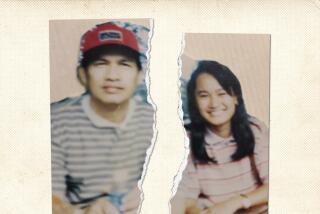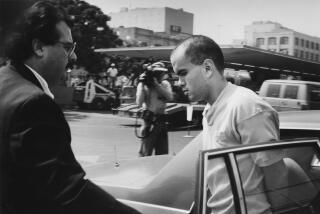Mystery Over Missing Body Stalks Alamo : Lawsuit: His stepdaughter accuses the religious figure of spiriting off the remains of his fourth wife. His countersuit claims he has been slandered.
Call it a morbid sideshow, a strange offshoot to the ongoing tribulations of religious figure Tony Alamo.
Stripped of his church’s holdings in four states, his flock thinning and awaiting trial on charges that he ordered the beating of a young boy in Saugus, Alamo has for more than a year been at the center of a bizarre mystery reaching from the hills of Arkansas to the San Fernando Valley.
Where is his former wife’s body? And who took it?
Those questions--and speculation on their answers--have spawned two lawsuits and a vitriolic battle that has pitted Alamo against his stepdaughter, a Reseda nightclub singer and mother of two who has not seen him in 20 years.
Christhiaon Coie, 41, has filed a lawsuit against Alamo accusing him of stealing her mother’s body from a mausoleum in Arkansas last year. Alamo, in turn, denies taking the body and has filed a lawsuit against Coie, accusing her of slander and defamation. It’s a war of words complete with religious invective and decades-old animosities, most of it contained in the pages of an ever-growing court file.
Coie said in court documents that Alamo has “behaved in a manner so heinous, it is almost hard to comprehend.”
For his part, the 57-year-old leader of the Holy Alamo Christian Church has responded that Coie’s allegations have caused thousands of souls to go to hell because his reputation has been so damaged that he is unable to save them. In a deposition given this year, he said: “This is like everlasting life harm, people’s souls spending eternity in a burning inferno, because of the things that this girl has said.”
In Arkansas, it is a felony to remove a body from a grave without court approval.
About the only thing both sides in the dispute agree on is that the body of Susan Alamo--the fourth of Alamo’s seven wives--was taken last year from the mausoleum on what was then church property near Dyer, Ark.
It is not the first time Susan Alamo’s dead body has drawn notice. After she died of cancer in 1982 at age 59, her husband received widespread attention when he reportedly claimed that she would be resurrected. He kept her body on display for weeks in a mansion near Dyer. And when the miracle did not occur, he finally interred her body in the marble mausoleum.
Susan and Tony Alamo had founded the Holy Alamo Christian Church, also known as the Susan and Tony Alamo Foundation, in the late 1960s when they began taking young dropouts, drug users and alcoholics off the streets and providing them with food, shelter and religious sermons. Alamo’s message was drawn from Christian fundamentalism.
Alamo used various ramshackle houses and apartments in the Hollywood area to house his flock before establishing a commune in remote Mint Canyon in Saugus. At times, hundreds of followers lived there.
Alamo, whose real name is Bernie L. Hoffman, also formed communes and started businesses in Arkansas and Tennessee. One of the firms distributed denim jackets with lavish rhinestone designs that sold for hundreds of dollars each.
The church is best known for circulating anti-Catholic and anti-government literature. It also drew the attention of cult-monitoring organizations and was the target of numerous government investigations over the years. The Internal Revenue Service has since stripped it of tax-exempt status, filed liens for $7.9 million in back taxes, and seized properties in California, Arkansas, Tennessee and Florida.
Although the church still distributes taped Alamo sermons to religious radio stations and literature through the mail, law enforcement authorities and cult experts have said the number of staunch followers has dwindled to probably 100 or fewer. As many as 50 of Alamo’s followers have crowded into courtrooms to witness proceedings involving him in the last year.
By all accounts, Susan Alamo’s body remained in the mausoleum in Arkansas until the night of Feb. 16, 1991, when the tomb’s marble facade was shattered, and the casket and body were removed.
At the time, the U. S. Marshals Service was preparing to seize the property to satisfy a $1.8-million judgment against Alamo and the church that had been won in a civil suit by five former followers who accused the church leader of stealing from them and cheating them out of pay for work in the church’s businesses.
Also at the time, Alamo was living in Tampa, Fla., under an alias--a fugitive from charges in Los Angeles County that he had ordered followers to beat a young boy at the commune in Saugus in 1988.
Crawford County Sheriff Bill Grill said Susan Alamo’s body was taken the same night that dozens of Alamo’s followers left the church property near Dyer. He said that there were no clues at the mausoleum and that the case remains unsolved.
“There is an open case, but it has been at a standstill for some time,” Grill said last week. “There is no telling where it went. The people who were living there left the same night, but we can only speculate about whether they took it.”
Before the theft, Susan Alamo’s daughter had obtained a restraining order that was taped to the mausoleum and prohibited anyone from disturbing it. Coie said in a recent interview that she sought the court order because she believed that her stepfather would attempt to take her mother’s body or order his followers to take it.
“I know how he thinks,” she said. “Unfortunately, it is not beneath him to do something like this.”
But the restraining order didn’t work.
A few days after the body was taken, Alamo called the editor of a Fort Smith, Ark., newspaper and was quoted in a story as saying, “I have it.”
However, the location of the body remained unknown--even after the fugitive evangelist was arrested in Tampa in July. Grill said he interviewed Alamo after his arrest, but the preacher denied taking the body, or ordering followers to take it, or making the statement to the newspaper.
Disbelieving the denial and angry that the whereabouts of her mother’s body were still unknown, Coie filed a lawsuit against Alamo in Arkansas late last year, accusing him of taking the body and demanding that it be returned and properly buried.
The suit contends that Alamo “willfully and wantonly engaged in extreme and outrageous conduct that was so outrageous in character and so extreme in degree as to go beyond all possible bounds of decency and to be regarded as atrocious and utterly intolerable in a civilized society.”
Coie has acknowledged that she cut off all contact with her mother and stepfather after leaving their church and home in 1971. But she has taken up the cause of finding her mother’s body because she says no one--dead or alive--deserves the “carnival-like” treatment that has occurred.
“My obligation is to bury my mother,” Coie said. “I will not allow him to do this. This is so hideous, so disgusting. In the United States, people even bury their pets. My mother is entitled to rest in peace.”
Alamo, who is believed to be living in California while awaiting trial in San Fernando Superior Court, declined through his attorney to comment on the dispute.
However, the attorney, Jeffrey Dickstein of Tulsa, Okla., criticized Coie for filing the suit and making a public spectacle of the case.
“She feels real compelled to take this public,” Dickstein said. “I think what she is doing is a disgrace.”
Dickstein said Alamo remains upset by the publicity but apparently not by the fact that his former wife’s body is missing.
“His basic position comes from the Bible, and he believes she is with God up in heaven and it doesn’t much matter where the remains are,” Dickstein said.
Alamo has filed a defamation suit against Coie seeking $3.5 million in damages--the losses to church businesses that Alamo attributes to her highly publicized allegations that he is a “grave robber.” In his deposition this year, he also counted lost souls among the damages.
“We used to win a hundred, two, three, four, five hundred, up to a thousand souls a day,” he said. “Now . . . if we get three or four or five souls a day, that’s something.”
In sometimes rambling answers to questions posed by Coie’s attorney, Charles Karr, Alamo also objected to his stepdaughter’s interest in the whereabouts of her mother’s body.
He said: “I don’t know how this girl that Susie disowned all these years ago, after 20 years of ignoring her mother, has a right to even come in and ask these questions of me, because it . . . seems to me that it doesn’t have anything to do with her at all, and she should just let her mother be laid at rest.”
Coie said settlement talks between her attorney and Alamo’s show that Alamo knows the location of the body.
“How can they negotiate for a settlement if they don’t have the body?” Coie said. “Tony knows where it is. He always has.”
For now, the legal battle seems far from over. Both sides say they will not back down, and the lawsuits may go to trial this year.
Even if the body of Susan Alamo is found, there is no indication that the animosities will cease.
Alamo perhaps illustrated this best during his deposition to Coie’s attorney: “To be honest with you, if I knew where the body was now, and it was in a safe place . . . I wouldn’t want to know, because then I’d have to answer you.”
More to Read
Sign up for Essential California
The most important California stories and recommendations in your inbox every morning.
You may occasionally receive promotional content from the Los Angeles Times.










